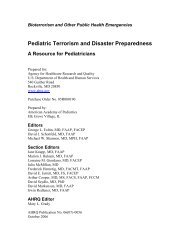H1N1 COUNTERMEASURES STRATEGY AND ... - PHE Home
H1N1 COUNTERMEASURES STRATEGY AND ... - PHE Home
H1N1 COUNTERMEASURES STRATEGY AND ... - PHE Home
Create successful ePaper yourself
Turn your PDF publications into a flip-book with our unique Google optimized e-Paper software.
NBSB Pandemic Influenza Working Group<br />
Detailed Report<br />
decision-making about isolation or treatment. But a negative result - you can’t do<br />
anything with that information. If you look at multiple viruses from different geographic<br />
samplings, you see that performance differs in the level of detection and sensitivity.<br />
Maybe we can identify bad performance, but we don’t have enough information to say<br />
how to use rapid tests in the best way.<br />
Dr. Neuzil: So for pediatric populations, we don’t have the data we want.<br />
Dr. Jernigan: Some data will be published soon.<br />
CAPT Fiore: Rapid tests are usually performed a few days into the illness. We usually<br />
get tests about 5 days in. It’s important to learn more.<br />
William Sheridan, M.B. B.S.: With a sensitivity of 12%, the value of a negative result<br />
is negative - people might die. Should those tests be retired? The ED doctor’s treatment<br />
is not guided by that. If the patient is sick, you treat him. Because influenza is evolving,<br />
and you add antigens to the vaccine yearly, shouldn’t the diagnostic platform recognize<br />
those? Should development and approval mechanisms, to get diagnostic tests out, look<br />
more like the annual event?<br />
Dr. Cantrill: That’s why many clinicians don’t have faith in rapid tests and evaluate the<br />
whole patient instead. If they’re sick enough to come to the hospital and may have<br />
influenza, they may get antivirals regardless of the test results. Consider that case we<br />
heard about from Salt Lake City - there were issues beyond testing, there were many red<br />
flags.<br />
Dr. Pavia: In that case, people ignored the clinical presentation because of a<br />
misunderstanding about a test that has poor performance.<br />
Dr. Hojvat: For rapid tests, manufacturers are not required to follow-up on changes in<br />
the virus, but for nucleic acid tests we did add the requirement to monitor and adjust for<br />
seasonal influenza. We put the onus on manufacturers and FDA will follow-up.<br />
Dr. Jernigan: The clinical use of the test plays a role. Sensitivity is affected by how the<br />
clinician uses the test.<br />
Dr. Pavia: That might be used in addressing scarcity.<br />
David Lakey, M.D.: We need to preserve the capacity to answer public health questions.<br />
In large States, we needed to identify pockets and move capacity around. We surged 10<br />
fold, from 20 tests per day to now 400 per day. We added equipment, but not enough to<br />
meet demand. I got in one day what we usually get in one season - 1,000 samples. The<br />
challenge is case definition. Early on, you need a broad net, but in this situation, the case<br />
definition was so broad that too many met it. So we sent information to ED doctors, and<br />
once we defined the case more narrowly, that took some pressure off. It’s important to<br />
identify whom to test. For example, where there were school closures, if they had one<br />
case, every school in the system sent us samples to test. Everyone who had traveled <br />
their employers wanted them tested.<br />
Surging is not just adding machines but also adding people, and not just in the lab, but in<br />
data entry, administration, etc. There’s no way my public health lab can be the clinical<br />
diagnostic lab for the whole State. We have focused on answering public health<br />
questions, and we’re pushing back on routine ILI, allowing some front-end screening<br />
before we get samples. We’re helping others ramp up their capacity. When I saw how<br />
we would fall behind, we de-linked treatment and testing, because there was no way we<br />
could deal with the backlog.<br />
65
















